Specialist
Tuberculosis had become increasingly widespread within the Metropolitan population. One-eighth of total mortality of all ages was due to the disease; in 75% of adult working class males, it was due to poor working conditions.
A committee was formed of the eight people present at the meeting and fund-raising began. The project proved popular and was given enthusiastic support by the medical profession and the philanthropic classes. Powerful supporters included Sir John Forbes, a Court physician, and Charlotte, Duchess of Norfolk, who brought it to the attention of Queen Victoria. The Queen became a patron, subscribing £10 a year.
On 25th May 1841 a public meetings was held at the Hanover Square Rooms to discuss the Hospital for Consumption and Diseases of the Chest. It was attended by many eminent medical and lay people. The Committee of the West London Dispensary for Diseases of the Chest (at No. 83 Wells Street) had also been invited, but declined the invitation. However, when the Committee heard of Rose's plans to provide in-patient beds (much desired by the Dispensary), it transferred its allegiance to the new venture and the Dispensary amalgamated with the Hospital.
Philip Rose became the Honorary Secretary to the new Hospital, until his death in 1883. He travelled the country, raising funds and establishing 14 Provident Associations.
When sufficient funds had been raised, an Out-Patients Department was established at No. 20 Great Marlborough Street. It opened on 28th March 1842.
The Dispensary and Out-Patients Department provided advice and medicines for TB sufferers, but facilities for in-patients were urgently needed and a 10-year lease was obtained on the Manor House in Smith Street, Chelsea.
Following adaption of the building, the first patients were admitted on 13th September 1842. The Hospital had 20 beds.
For admittance, as with other voluntary hospitals, patients needed a recommendation from a governor or a subscriber, although the medical staff could refer a small number of patients seen in the Out-Patients Department.
By May 1843 the demand for beds had increased to such a degree that the Hospital Committee decided that a wing with 50 beds needed to be added. However, the Committee later changed its mind and resolved instead to look for a new site on which to erect a purpose-built hospital suited to the needs of tuberculous patients.
After 'much difficulty', a 3-acre site was eventually acquired on the north side of Fulham Road in Brompton, then a village surrounded by market gardens. The land was leased from the Trustees of the Henry Smith Charity at a ground rent of £170 a year, on the understanding that the Hospital would be allowed to buy the freehold when funds permitted (it was finally purchased in 1868 for £6,500).
The Hospital was to be built in stages, as funds became available. On 11th June 1844 the foundation stone for the first part - the west wing - was laid by Prince Albert, who arrived on horseback from Buckingham Palace.
The Hospital opened in 1846 with 85 beds. The building had cost £11,762 and consisted of the west wing and half of the central linking block, which included the main entrance.
The ground floor contained the Out-Patients Department, administrative offices, a laboratory, a dispensary and a museum. The wards for the female patients were on the first floor and those for males on the second floor. Their ceilings were 14 ft (4.2 metres) high. Each ward contained no more than 8 beds. One of the features of the wards was the ventilation system, which forced in warm air - an attempt to create the temperature found in southern latitudes (deemed to be beneficial to TB patients then). The wards opened up into 10 ft (3 metres) wide corridors, which could be used as day rooms. Dormitories for the nursing and domestic staff were located in attic rooms on the north side of the Hospital. A separate servants' staircase ensured they had no direct access to the ward floors.
By November 1846 some 60 beds were in use. All patients were desired to bring a change of linen, a cup and saucer, a knife and fork, a teapot and a teaspoon. Despite the lack of any definitive treatment, patients responded to a regime of good nourishing food, including cod liver oil.
The former in-patients building in Manor House remained in use as a convalescent home and for patients awaiting admission to the Brompton site. (It closed in 1871, when it was demolished and its site redeveloped.)
In 1847 a small gabled porter's lodge was built in the southwest corner of the site.
In July 1848 the famous singer Jenny Lind (the 'Swedish nightingale') gave a concert at Her Majesty's Theatre to raise funds for the building of the east wing. It raised £1,606 - equivalent to £90,000 today.
In 1850 a chapel was built to the north of the Hospital, following a donation of £1,500 from the Revd Sir Henry Foulis. It was linked to the Hospital by a long corridor. (The chapel was enlarged in 1892).
Work began on the building of the east wing and the remaining half of the central linking block. It was completed in 1852 at a cost of £4,854.
The Hospital building was H-shaped, with the depth of each wing 190 ft (58 metres) and the width of the building 200 ft (61 metres).
In 1853 a detached block was built to the north of the central corridor. It contained a kitchen, sculleries and administrative offices. The Hospital was then completed and had 220 beds.
In the same year the Hospital Committee purchased 4 acres of land on the west side of the site. Half an acre of this was added to the Hospital grounds, while the rest was saved for speculative house building.
Plans had been made in 1852 for a sanatorium with 30 to 40 beds to be built at Bournemouth for patients who needed long-term case. It opened in 1855, but transportation proved difficult and so it was deemed unsuitable. (The sanatorium eventually became independent and was known as the Royal National Sanatorium.)
By 1867 the Hospital was known simply as the 'Brompton Hospital'.
In 1868 the Committee acquired a group of houses on the south side of Fulham Road, opposite the Hospital. Some of these were used to accommodate in-patients and, in 1872, a subway was built to connect them to the Hospital at a cost of £1,150.
In 1871 the Hospital had received a substantial legacy (£100,000) under the will of the late Miss Cordelia Angelica Read (the will had been found in the locked drawer of a spinet at the Hospital). This money enabled the Committee to extend the Hospital. The houses on the south side of Fulham Road were demolished in 1879 and the Prince of Wales laid the foundation stone for a new building - the South Block - which was completed in 1882 at a cost of £65,976.
The South Block was officially opened on 13th June 1882 by the 15th Earl of Derby, the President of the Hospital. It contained a large Out-Patients Department, ten wards (each containing from 1 to 8 beds), a Lecture Room and quarters for resident staff.
At the end of the 19th century there were scientific breakthroughs. In 1882 Robert Koch, a German physician, discovered the cause of tuberculosis - Mycobacterium tuberculosis - while, in Italy, Carlo Forlanini invented the artificial pneumothorax, a technique to collapse the lung to allow it to rest. (However, it was not until October 1911 that the first artificial pneumothorax was performed at the Hospital.)
In 1895 Wilhelm Roentgen discovered X-rays, which were to become a powerful tool in assessment of the disease.
At the end of the 19th century, a 4-storey Nurses' Home was built in South Parade, behind the South Block, at a cost of £32,000. It opened in 1899.
In 1900 an X-ray Department was established (and later expanded in 1925).
At the beginning of the 20th century the Hospital was the largest tuberculosis hospital in the country, with a bed complement of 368. Although it dealt primarily with patients suffering from TB (70%), a number of other departments dealt with other diseases of the chest.
On 13th September 1900 the Hospital Committee purchased 20 acres of land at Chobham Ridge for £3,900 on which to build a sanatorium with 150 beds for long-stay patients. The Brompton Hospital Sanatorium was officially opened on 25th June 1904 by the Prince of Wales. However, because of heating, plumbing and staffing problems, the first patients were not admitted until March 1905.
In 1906, because laryngeal TB was a common complication of the pulmonary form, a Throat Department was established (and later extended in 1922).
In 1919 a Cardiac Department opened and, in 1934, a Physiotherapy Department, initially to provide breathing exercises (it proved a great success and, by 1948, was staffed by 6 full-time and 1 part-time physiotherapists).
In 1924 the nursing staff consisted of a Matron, 12 Sisters and 64 nurses.
During the 1920s and 1930s extensions were built on the north side of the original building and at the western end of the South Block. In 1935 an extra floor was added to the Nurses' Home.
In 1941, during WW2 (1939-1945), the Hospital was damaged by fire when bombs fell nearby. In 1942 the Nurses' Home and the South Block were badly damaged by a landmine.
In 1948 the Hospital joined the NHS as a Teaching Hospital with 368 beds, and 150 in the Sanatorium at Frimley. It amalgamated with the London Chest Hospital to form the Hospitals for Diseases of the Chest, under the control of a single Board of Governors.
On 26th October 1949 the Institute of Diseases of the Chest (later renamed the Cardiothoracic Institute) opened in a single-storey building on the east side of Foulis Terrace.
As drug treatment with streptomycin for tuberculosis became increasingly available, the focus of the medical staff turned to other conditions of the lungs and heart.
In 1958 a 4-storey laboratory block was built to the north of the Institute to provide additional research facilities.
In 1961 a plan was put forward for several specialist hospitals to be grouped together on the sites of the nearby St Luke's Hospital and the Chelsea Hospital for Women. However, despite much debate, the project never materialised.
In the mid 1960s the South Block was extended, as was the Institute. In 1966 a projecting sun lounge was added to the main front of the Hospital at the first-floor level. The Hospital had 351 beds. In 1967 further alterations were made to the South Block.
In 1971 the National Heart Hospital in Westmoreland Street merged with the Hospitals for Diseases of the Chest. The group then formed the National Heart and Chest Hospitals (later becoming the Royal Brompton National Heart and Lung Hospitals).
In the mid 1970s, after St Luke's Hospital closed, the Hospital took over its premises.
Following a major reorganisation of the NHS in
1892, the Hospital became a Designated Teaching Hospital with its own Board of Governors. It had 332 beds and an additional 110 at Frimley.
In 1985 the nearby St Wilfred's Convent in Cale Street, which had moved to new premises in Tite Street in 1976, was converted into a research centre for the Hospital.
At the end of the 1980s the Hospital took over the site of the Chelsea Hospital for Women, which had moved to Queen Charlotte's Hospital. The building was renamed the Chelsea Wing.
In 1991 the Hospital was renamed the Royal Brompton Hospital. It had 250 beds.
In 1991 the National Heart Hospital closed its premises in Westminster and moved to a building - the Sydney Wing - built on the site of the former St Luke's Hospital.
In 1994, following the introduction of the 'market-place' system in the NHS, the Royal Brompton NHS Trust was formed. The Hospital had 290 beds.
In 1998 the Hospital merged with Harefield Hospital in Uxbridge, under the control of the Royal Brompton and Harefield NHS Trust. It became the largest cardiothoracic centre in the U.K.
At the end of the 1990s the original Hospital building north of the Fulham Road had been sold and converted into an apartment block. However, the South Block, now renamed the Fulham Wing, remained in use as the Out-Patients Department.
In 2000 the former Nurses' Home of the Chelsea Hospital for Women, on the corner of Dovehouse Street, became the Britten Wing. The former fire station on South Parade was also taken over by the Hospital.
Present status (August 2008)
The Brompton Hospital Sanatorium at Frimley closed in 1985.
The original Hospital buildings on the north side of Fulham Road were converted into a residential development by Northacre plc in 1997. It is now The Bromptons, located in Rose Square (named after Sir Philip Rose, founder of the Hospital).
The Hospital remains operational with 312 beds. It consists of four parts:
The Chelsea Wing (the former Chelsea Hospital for Women) currently houses the non-invasive cardiac service.
The Sydney Wing, built on the site of St Luke's Hospital, is used for the treatment of, and research into, heart and lung conditions.
The Britten Wing (the Nurses' Home for the Chelsea Hospital for Women), contains facilities for private patients.
The Fulham Wing, formerly known as the South Block, contains the Out-Patients Department and in-patient respiratory services.
UPDATE: 31st December 2016
In 2009 the NHS Trust became an NHS Foundation Trust.
On 5th July 2010 a new Respiratory Biomedical Research Unit opened to provide a clinical research facility for the study of heart and lung diseases. In the same year, on 15th November, a Cardiovascular Biomedical Research Unit opened for the study of poor heart function.
In 2013 the Hospital announced plans to consolidate its campus within Dovehouse and Sydney Streets. Various properties - the Fulham Wing, Nos. 1-11 Foulis Terrace, Nos. 117-125 Sydney Street (including Chelsea Farmers Market), No. 151 Sydney Street, No. 250 King's Road, Dudmaston Mews, and the former Fire Station and Trafalgar Chambers in South Parade, would be sold off.
The neighbouring Royal Marsden Hospital immediately expressed an interest in purchasing the Fulham Wing, but could only offer £30m instead of the £130m expected were the building sold to developers.
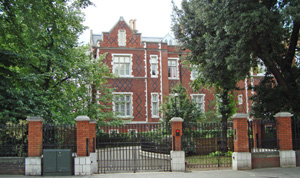
The original Hospital building - the North Block on the northern side of Fulham Road - is now The Bromptons in Rose Square (above and below).
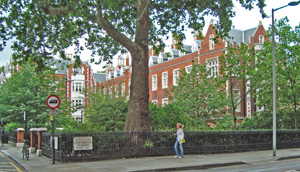
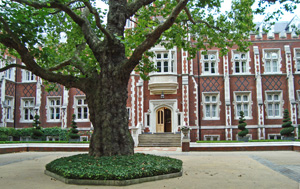
The main entrance to the North Block.
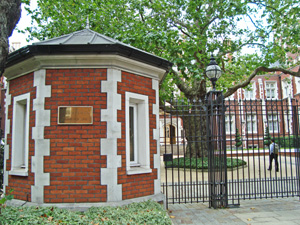
The porter's lodge to The Bromptons bears signage for the new name.
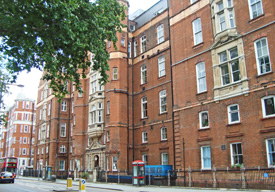
The northern elevation of the South Block, on the southern side of Fulham Road. The building is still in Hospital use and is now called the Fulham Wing.
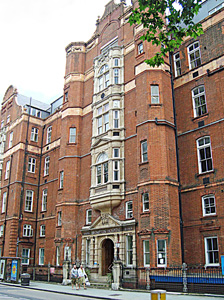
The main entrance to the Fulham Wing on Fulham Road (above and below).
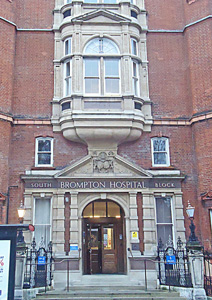
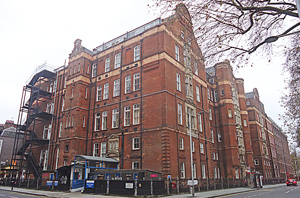
The eastern corner of the Fulham Wing on Dovehouse Street and Fulham Road.
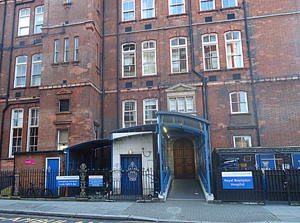
The entrance to the Fulham Wing on Dovehouse Street.
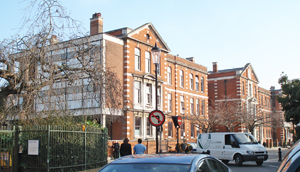
The Chelsea Wing (above and below) was once the Chelsea Hospital for Women.
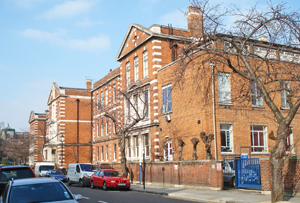
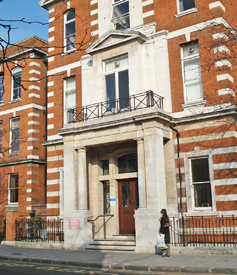
The main entrance to the Chelsea Wing.
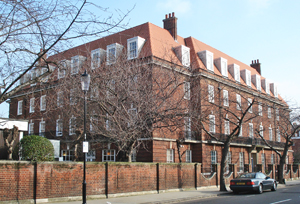
The Britten Street Wing (now known as the Britten Wing) was once the Nurses' Home for the Chelsea Hospital for Women.
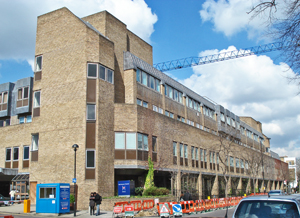
The Sydney Wing (above and below) was built on the site of St Luke's Hospital by Watkins Gray International at the end of the 1980s.
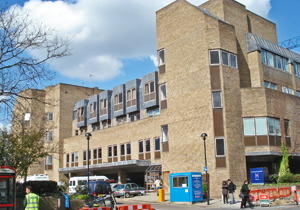
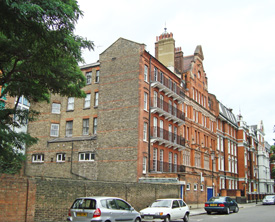
Trafalgar Chambers and the old fire station on Southern Parade belong to the Hospital.
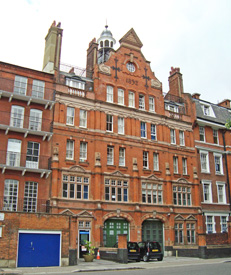
The old fire station on Southern Parade is now the Royal Brompton Centre for Sleep. Trafalgar Chambers is the block on the left.
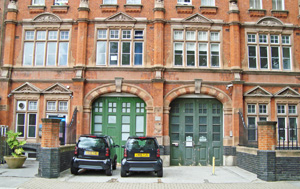
The old double doors of the fire station remain.
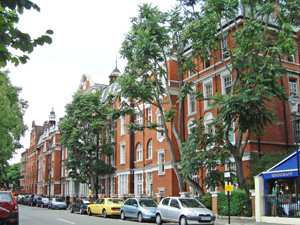
The Nurses' Home in South Parade opened in 1899 (above and below). It now houses the Clinical Skills and Simulation Centre.
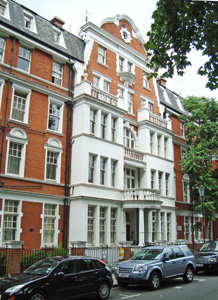
The main entrance to the Nurses' Home (above and below).
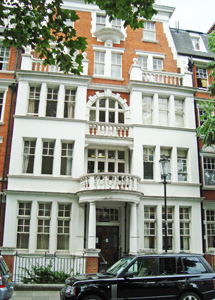
N.B. Photographs obtained in December 2016
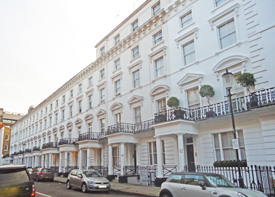
Nos. 1-11 Foulis Terrace. The mid-19th century stucco houses are Grade-II listed. Currently, they are in use by the Hospital as 'houses in multiple occupation'.
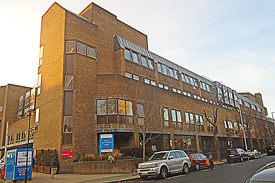
The facade of the Sydney Wing along Sydney Street.
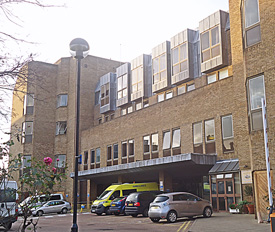
Its main entrance, just off Sydney Street.
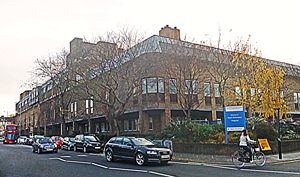
The Sydney Wing on the corner of Sydney Street and Cale Street.
Bishop PJ 1979 The History of the Brompton Hospital. Transactions and Studies of the College of Physicians of Philadelphia 1, 171-182.
Bishop PJ, Lucas BDB, Lucas BGB 1991 The Seven Ages of the Brompton. A Saga of a Hospital. London, Royal Brompton, National Heart and Lung Hospitals, Board of Governors.
Cormack, Semple 1851 The Hospitals of London. No. VII. London Journal of Medicine 3, 751-759.
Davidson M, Rouvray FG 1954 The Brompton Hospital. London, Lloyd-Luke (Medical Books) Ltd.
Hurt R 2004 Tuberculosis sanatorium regimen in the 1940s: a patient's personal diary. Journal of the Royal Society of Medicine 97, 350-353.
Porter FJW 1912 A visit to the Brompton Hospital Sanatorium at Frimley. Journal of the Royal Army Medical Corps 18, 169-172.
http://archiseek.com
https://en.wikipedia.org
https://thefightagainsttuberculosis.wordpress.com
www.aim25.ac.uk
www.british-history.ac.uk
www.flick.com
www.getwestlondon.co.uk
www.gov.uk
www.londongardensonline.org.uk
www.londononline.co.uk
www.ncbi.nlm.nih.gov
www.ph.ucla.edu
www.rbhh-specialistcare.co.uk
www.rbht.nhs.uk (1)
www.rbht.nhs.uk (2)
www.rbkc.gov.uk (1)
www.rbkc.gov.uk (2)
www.rbkc.gov.uk (3)
www.royalbromptonredevelopment.org
www.standard.co.uk
www.theguardian.com
Return to home page